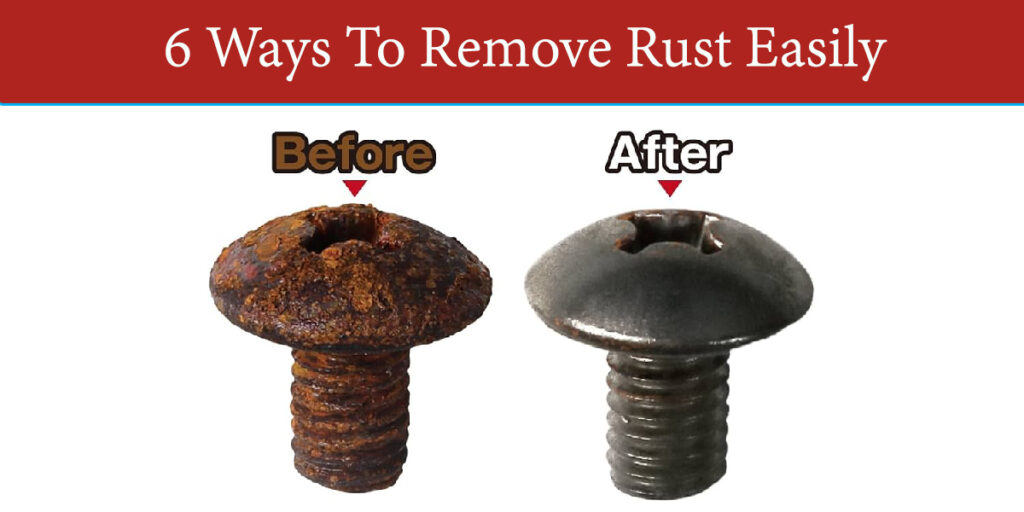Rust is the bane of any metal object. Whether it’s a cherished tool, a valuable car part, or household fixtures, rust can significantly damage metal, making it weaker and aesthetically unpleasant. Rust is the result of iron reacting with oxygen and moisture over time, forming iron oxide—a reddish-brown crust that corrodes metal surfaces. If left untreated, rust can degrade the structural integrity of metal items. Thankfully, there are various effective methods to remove rust and prevent further corrosion. In this article, we’ll explore multiple techniques to remove rust from metal, along with tips on rust prevention.

Understanding the Science of Rust
Before diving into the methods of rust removal, it’s important to understand how rust forms. Rust, or iron oxide, occurs when iron, oxygen, and water come into contact. This combination triggers an electrochemical process called oxidation. As a result, rust develops and eats away at the metal, often spreading rapidly in humid or wet conditions.
Different metals, like stainless steel, are more resistant to rust, but no metal is entirely rust-proof. Regular exposure to moisture, salty air, or chemicals can cause even the most durable metals to corrode over time.
Methods for Removing Rust from Metal
Here are several tried-and-tested methods to remove rust from metal objects. These methods range from DIY household techniques to industrial solutions, so you can choose the one that best suits your needs.
1. Vinegar Soak
One of the most common and effective household remedies for rust removal is white vinegar.
How to use vinegar to remove rust:
- Submerge the rusted item in white vinegar and let it sit for several hours or overnight, depending on the severity of the rust.
- After soaking, remove the loose rust using steel wool or a scrub brush.
- Rinse the object with water and thoroughly dry it to prevent further rusting.
For larger objects that cannot be soaked in vinegar, soak a cloth or sponge in vinegar and apply it directly to the rusted area.
Pro tip: You can also add salt to the vinegar to boost the cleaning power. Salt increases the acidity of the solution, which can help remove more stubborn rust patches.
2. Baking Soda and Water Paste
If you’re dealing with minor rust on small objects, baking soda is a gentle yet effective rust remover.
How to use baking soda:
1.To make a thick paste, combine water and baking soda.
2. Apply the paste to the rusted area, ensuring it covers all affected spots.
3. Let it sit for a few hours to allow the baking soda to break down the rust.
4. Scrub the area with a toothbrush or scrub pad, then rinse and dry thoroughly.
5. Baking soda is less abrasive than some other methods, making it ideal for delicate metal items.
3. Lemon Juice and Salt
Lemon juice is another mild acid that works well for rust removal, especially when combined with salt.
Steps for using lemon juice and salt:
- Sprinkle salt on the rusted area, covering it completely.
- Squeeze lemon juice over the salt and let the mixture sit for 2-3 hours.
- Scrub the area with a brush to remove the rust, then rinse and dry the object.
- The combination of salt and lemon juice creates a chemical reaction that helps dissolve rust without damaging the underlying metal.
4. Using Commercial Rust Removers
For more severe rust problems, commercial rust removers are a viable option. These products are specifically formulated with chemicals that target rust and dissolve it.
How to use commercial rust removers:
- Follow the manufacturer’s instructions closely. Most require you to apply the product to the rusted area and let it sit for a specific period.
- Use a scrub brush or cloth to remove the rust.
- Rinse the object thoroughly and dry it completely.
- Commercial rust removers can be quite strong, so it’s important to wear protective gloves and work in a well-ventilated area.
5. Electrolysis Rust Removal
Electrolysis is a more advanced rust removal method but is highly effective for large or intricate metal items. This technique involves using an electrical current to break the bond between rust and the metal surface.
What you need for electrolysis:
• A car battery charger
• A non-metallic container (like a plastic tub)
• A sacrificial piece of metal (e.g., a steel plate)
• A washing soda solution (sodium carbonate)
Steps for electrolysis:
- Fill the container with water and add a few tablespoons of washing soda to create an electrolyte solution.
- Attach the positive clamp of the battery charger to the sacrificial metal and submerge it in the solution.
- Attach the negative clamp to the rusted object and submerge it in the solution, ensuring the two pieces of metal don’t touch.
- Turn on the charger and let the current flow. The rust will slowly detach from the object and attach itself to the sacrificial metal.
- This method is highly effective for heavy rust but requires careful handling due to the use of electricity and chemicals.
6. Steel Wool and Abrasive Scrubbers
For minor rust spots, physical abrasion using steel wool, sandpaper, or a wire brush can effectively remove rust without any chemicals.
How to use abrasive tools:
- Use fine or medium-grade steel wool to scrub the rusted area in circular motions.
- For larger patches of rust, sandpaper or a wire brush may be more efficient.
- After scrubbing, rinse the metal object with water and thoroughly dry it.
- While this method can be labor-intensive, it’s perfect for small, easily accessible rust patches or for giving a finishing touch after chemical treatments.
Preventing Future Rust
Once you’ve removed the rust from your metal objects, it’s crucial to take steps to prevent future rust formation. Apply Protective Coatings: Use rust-resistant primers, paints, or clear protective coatings like oil or wax to seal the metal and prevent moisture from coming into contact with the surface.










Магазин аккаунтов https://marketplace-akkauntov-top.ru